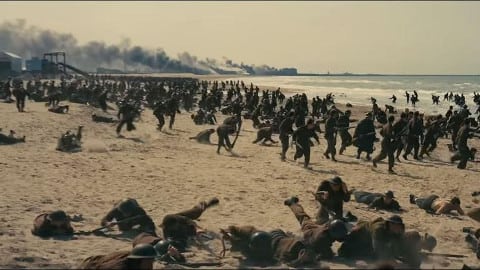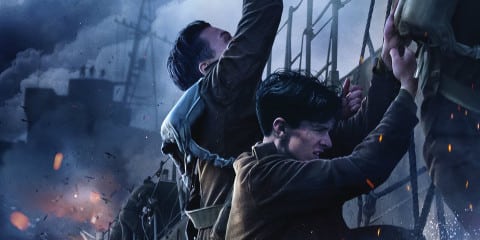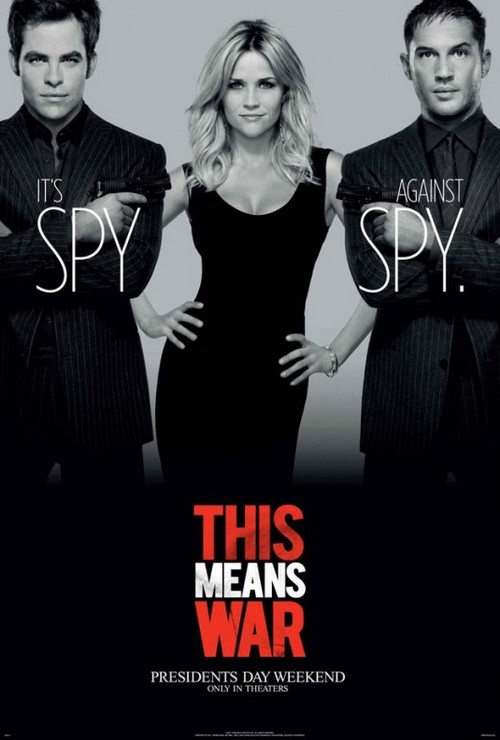Dunkirk (2017)
Directed by: Christopher Nolan
Written by: Christopher Nolan
Starring: Aneurin Barnard, Fionn Whitehead, Mark Rylance, Tom Hardy
UK
IN CINEMAS NOW
RUNNING TIME: 106 mins
REVIEWED BY: Dr Lenera, Official HCF Critic
In 1940, after the invasion of France by Nazi Germany, thousands of Allied soldiers retreat to the seaside city of Dunkirk. As the surrounding British perimeter shrinks, the soldiers await evacuation, a seemingly hopeless situation. Dunkirk focuses on three stories interwoven in a non-linear fashion:
i/ The Mole
British private Tommy manages to make it from the streets of Dunkirk to the beach where he and another soldier Gibson desperately try to get onto a ship home but are constantly thwarted….
ii/ The Sea
The Royal Navy is commandeering private boats to participate in the evacuation. Mr Dawson cooperates without question, but rather than let a navy crew take his boat, he and his son Peter take her out themselves, accompanied by their teenage hand George….
iii/ The Air
Three Spitfire pilots – Farrier, Collins, and their squadron leader – are underway across the English Channel to provide air support to the troops waiting at Dunkirk, with instructions for how much fuel they can spend there before needing to return….
Dunkirk is 106 minutes of riveting, exhausting and terrifying intensity, a war movie that is as much a disaster movie. I’m not sure that it’s the kind of film that you actually enjoy that much, but it’s certainly one that you have to experience on the big screen. One of the things that makes it so noteworthy is that it dispenses with many of the usual war film cliches, at least as seen in many recent examples of the genre. There’s no build-up – we’re thrown into the mayhem immediately with only a few on-screen lines serving as scene-setting, meaning that [I believe writer/director Christopher Nolan has said something to this effect] the entire movie is basically the final act of a huge epic. There are no character back stories. There’s no sentimentality. The last two points may make it seem that the film has no emotion, but actually it’s there, just a little muted and focusing on the general horror and tragedy of the Dunkirk evacuations, and yet, in what is another interesting feature, we never see any actual German soldiers. And, rather than concentrate on either one major focus point or a great many of them as is the norm, Dunkirk hems in on three, each representing a major viewpoint, and cuts between the three plotlines, one of them lasting a week, one a day, and one an hour, which allows Nolan to play with time, something he’s enjoyed doing ever since his first picture Momento.
The first image we have is of soldiers wondering through an empty Dunkirk street while bits of paper are blown around in the wind, the first of quite a few rather beautiful [I know, that word seems out of place but if you see the film then you’ll see what I mean and if you have already seen it than you’ll know what I mean] shots by cinematographer Hoyte van Hoytema who deserves a mention this early on because his work in this film is absolutely stunning. Suddenly all the soldiers are shot dead except for one, and the first time you hear the bullets it’s quite shocking and tellls you that the sound design in this film isn’t for the faint hearted, though you’ll probably get used to it. Apparently some Dunkirk survivors have said that stuff in the film is actually louder than they remembered, but it feels convinving, and I think that we can give Nolan and his sound engineers some slack here – after all nearly every film is a heightening of some kind. One thing I was pleased with right away was that the audio flaws of Nolan’s last film Interstellar [which sadly made their way on to the Blu-ray and I assume the DVD too] aren’t repeated in Dunkirk. Here, you can hear everything people are saying without it being drowned out by sound effects and score. Somebody told me that some are complaining about the sound mix for Dunkirk anyway, but I can honestly say that I had no problems with it.
So we have Tommy, who manages to get to the beach and team up with another soldier Gibson. Together, they keep trying to leave for England but are either denied entry on to a ship or the ship they get on is sunk. This portion of the film sometimes cuts to Commander Bolton and Colonel Winnant and gives us some idea of the bigger picture. The Prime Minister has rejected German surrender offers, and has committed to evacuating 30,000 soldiers, but the military has decided to requisition smaller civilian vessels for the evacuation in order to preserve the larger ships for the defense of Britain. One of these civilian vessel is captained by a Mr Dawson, with his son Peter and teenage deck hand George on board. They encounter a shell-shocked soldier on the wreck of a ship, the sole survivor of a U-boat attack, and take him aboard, but he’s none to happy when he finds out he’s heading straight back to Dunkirk and trouble ensures. And then there’s the three Spitfire pilots heading for Dunkirk, the portion that only lasts an hour in real time. Farrier’s fuel gauge malfunctions, but they all continue onwards nevertheless engaging in dogfights with Luftwaffe planes along the way.
The intercutting between the three stories sometimes sometimes speeds up, and sometimes slows down a little, but it allows, for example, events to be shown from different points of view and a plane’s run that probably took thirty seconds appear to take exactly as long as a sea rescue that lasted hours – yet if you were left scratching your head rather too much for comfort by things in Inception and Interstellar rest assured, everything becomes easy to follow after ten minutes or so once you adjust to the style. Now I usually briefly refer the music of a picture at the end of a review but I’m mentioning Dunkirk‘s score here because for better or worse it’s very prominent in the film’s overall design and pretty much takes presidence over dialogue. Kind of a cross between his scores for Black Hawk Down [now there’s an underrated war movie] and Interstellar though mostly without Interstellar‘s lyrical passages [but the rhythm and the way the music is applied is virtually the same], Nolan’s usual collaborator Hans Zimmer’s minimalist score, often based on a ticking clock which is sometimes distorted so it becomes more like a heartbeat, goes for visceral tension and certainly achieves it, though it also never shuts up and is rather overused. Some moments, such as a brief breather on a nearly deserted area of the beach, would have had more impact in my opinion with no music at all, but then Nolan obviously never wanted the viewer to relax. Late in the film we here some snatches of a Vangelis-like variation on Edward Elgar’s incredibly emotive piece Nimrod. I’ve often criticised Zimmer in the past, not least for the way he plagiarises other music, but at least Elgar is credited here. And I have to admit that his work on this film is tremendously effective.
The characters are never far away from a bullet, a bullet or a torpedo, but what makes Dunkirk actually rather frightening is the way so many phobias are shown and skillfully interwoven into the story: fear of confined spaces, fire of darkness, fear of drowning, fear of abandonment, etc. And eventually the sight of a distant German plane becomes the most terrifying thing possible [the way this film is handled, it’s not that far from being a horror film]. Many were disappointed when Nolan, as he usually does, went for the ‘PG-13’ rating for this film, meaning that he wouldn’t be able to show the bloody graphicness of war [something Hacksaw Ridge took to extremes]. However, Dunkirk is so intense and scary that I certainly didn’t think that it was any weaker for this. Perhaps more difficult to get used to is the way that we don’t get character flashbacks or even conventional character introductions. This is one of those films where you pick up little bits of information or hints as to what characters are like by just watching them in action. You had quite a few films like this in the 1970’s, but it’s not done much today. This approach does mean that one may not always care too much when people are killed. However, watch the body language and facial expressions of the main characters and you’ll certainly learn stuff about every single one of them. A certain Harry Styles acquits himself very well, so much so that I’ll be most happy if he now chooses a career in movies and gives up his day job. Tom Hardy gets another role where he just sounds odd. Perhaps Mark Rylance fares best of all, but doesn’t he in every film he’s in?
Hoytema’s camera every now and again pulls back to give us the bigger picture, which is where the minimal use of CGI and employment of real World War 2 craft really pays off [okay there’s a bit of obvious back projection, but CGI backdrops can look even more fake if not done well], but likes to keep things intimate and tight without getting all shaky. There are lots of little images throughout which add to the overall feel of a nightmare despite the odd shot that can’t help but be rather beautiful, like flames engulfing the ocean. Something that stuck in my mind was when soldiers stand by the surf’s edge, and the surf has become an ugly, filthy-looking froth. Even nature is being transformed by this man-made evil called war. As to whether this is Nolan’s finest picture it’s hard to say. To me, Interstellar was both an epic and an emotional experience of the kind I hadn’t had in the cinema for some time, though it’s quite a divisive film and The Prestige and Inception seem to reveal new layers with each successive viewings so it’s possible that in the future I will see them as better pictures. The Dark Knight probably remains the popular choice though, as well put together as they are, I find the Batmans to be Nolan’s least interesting efforts. There’s no doubt though that Dunkirk is proof that he’s one of the best directors working within the increasing confines of the Hollywood studio system today, and that he’s made a war movie that deserves to be ranked with the best of the genre. And yes, it is moving. Having one of the survivors read out Churchill’s famous address rather than making us hear Churchill’s voice yet again ought to deeply touch anybody.
Rating: 

















Be the first to comment